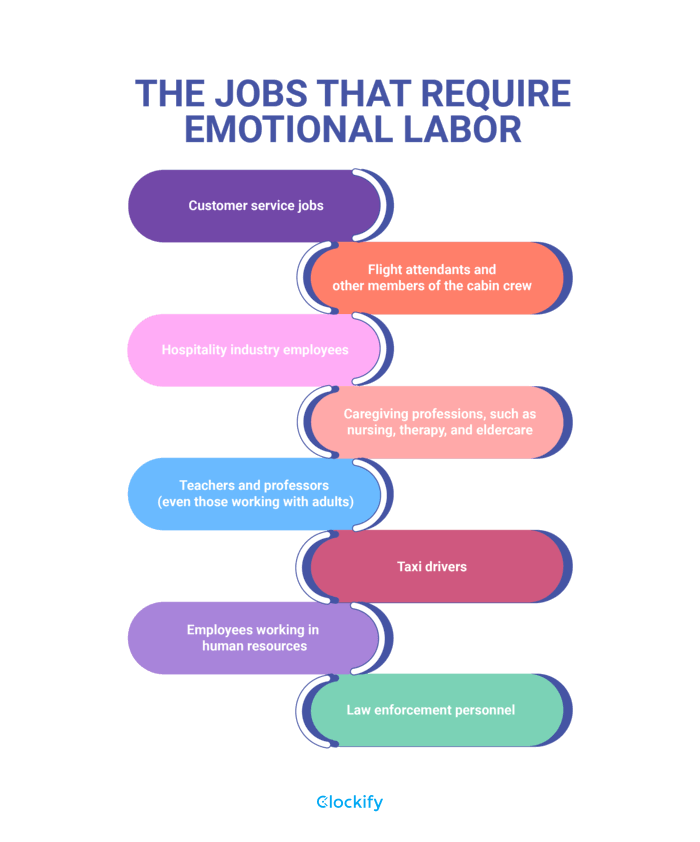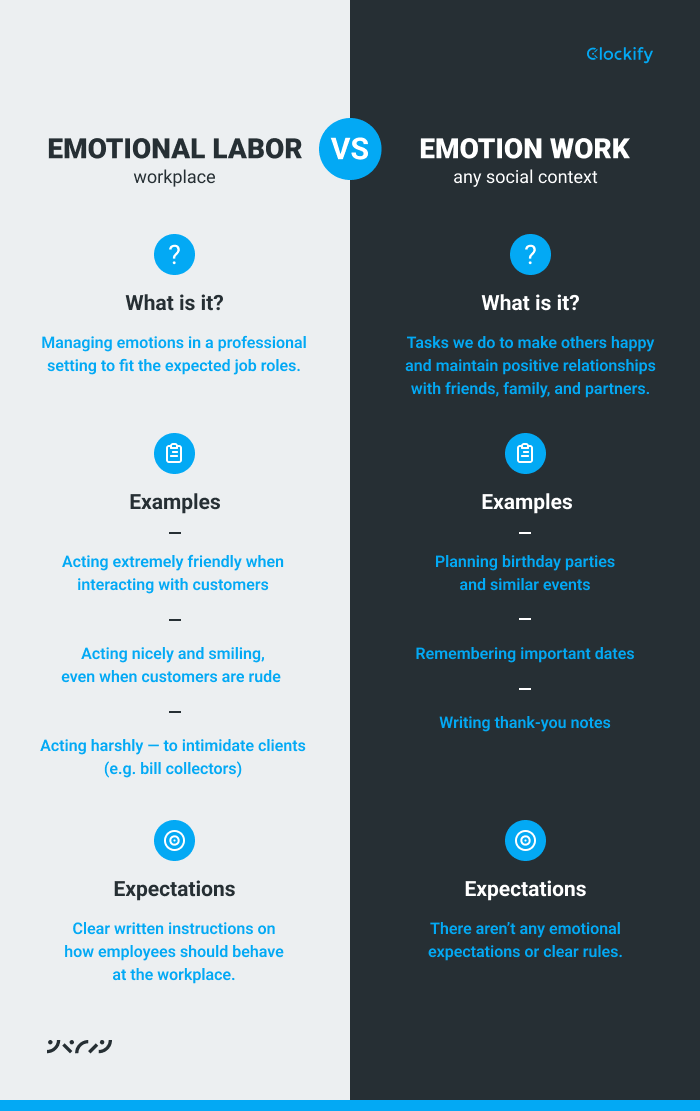To meet work demands, employees sometimes have to pretend to feel something that they don’t actually feel — to impress their boss or satisfy their customers’ needs.
And that’s emotional labor in action.
But let’s see who’s credited for creating this term in the first place.
What is emotional labor?
The person who came up with the term emotional labor was Arlie R. Hochschild — a highly regarded sociologist and professor emerita at the University of California, Berkeley.
In an interview for the Atlantic, Hochschild explains that emotional labor is “the work for which you’re paid, which centrally involves trying to feel the right feeling for the job.”
Not all jobs require managing emotions. Some occupations, however, require workers to adjust their feelings to fit the workplace demands better. Let’s check out a few of those jobs.
The jobs that require emotional labor
The authors of Emotional Labor in the 21st Century identify 3 shared traits of work positions that require high levels of emotional labor:
- Jobs that involve interaction with consumers, customers, and clients,
- Workplaces where workers have to evoke particular emotions from other parties, and
- Jobs in which employers hold control over their employee’s feelings.
Now, what job roles are linked to emotional labor? Here’s a list of a few common ones:
- Customer service agents,
- Taxi drivers, and
- Nurses.
If you want to learn about more occupations that require emotional labor, see the graph below:

As the graph shows, emotional labor goes beyond the service industry. Yet, the levels of emotional labor in employees differ depending on the sector of work. For example, an HBR article on emotional labor in the on-demand industry argues that workers in an app-based service (like Uber, Airbnb, TaskRabbit) face high levels of emotional labor.
Namely, such firms have customer rating systems, meaning that employees must achieve almost perfect reviews — to avoid being deactivated.
As a result, these workers need to:
- Provide customers with near-impeccable service, and
- Adapt their emotional performance to suit employer and customer expectations.
Emotional labor vs. emotion work
People often make a mistake when they use the term emotional labor interchangeably with the term emotion work — yet another concept Hochschild coined.
In simple terms, emotional labor means managing your emotions in a professional setting to fit the expected job behaviors.
In contrast, emotion work involves all the tasks people do to make others happy and maintain positive relationships with their family, partners, and friends.
For example, performing emotion work means doing tasks such as:
- Buying presents,
- Writing thank-you notes,
- Remembering important dates,
- Planning birthday parties and similar events, and
- Calling to check in on your acquaintances and family regularly.

What are the consequences of emotional labor?
Typical consequences of emotional labor include:
- Burnout,
- Fatigue, and
- Emotional exhaustion.
Let’s take a look at each individual consequence in more detail.
Consequence #1: Burnout
In their journal article on emotional labor, researchers Morris and Feldman write that employees progressively undergo burnout when their capacity for emotional dissonance drains — a result of emotional labor. In short, emotional dissonance is a clash between the emotions we feel and those we display.
So, when workers constantly need to manage their feelings, they become tired and experience an energy dip. As a result, they start to suffer from burnout.
Consequence #2: Fatigue
Interestingly, another study on the impact of emotional labor on health points to a survey of employees working in the hotel industry. The survey included 1,320 employees from 5 hotels in Seoul, South Korea. Their results discovered a strong link between emotional labor and fatigue.
They also found that female hotel workers were more likely to experience emotional labor, leading to “higher levels of fatigue,” than their male coworkers.
Consequence #3: Emotional exhaustion
For a quick definition, the Mayo Clinic describes emotional exhaustion as “a state of feeling emotionally worn out and drained.” As such, emotional exhaustion is usually caused by stress, and it often gets worse over time. To that effect, emotional labor is tightly linked to increasing amounts of stress.
Likewise, a study on the health effects of emotional labor cites a survey including 703 Chinese teachers and elaborates on how emotional labor impacts them.
In short, they found that teachers were more prone to emotional exhaustion when engaged in surface acting (that’s when workers hide how they really feel and fake the desired emotions — i.e., the emotions someone expects them to express in a particular role).
How to deal with emotional labor
As you can tell, employees often face dire consequences of emotional labor.
Yet, managers and employees can adopt methods to prevent such extreme outcomes.
Tips for employees on how to deal with emotional labor
Employees in certain lines of work have no choice but to adapt their feelings to fit their roles better.
In such cases, it’s almost inevitable that they’ll experience emotional labor. But here’s how to deal with this issue more effectively as an employee.
Tip #1: Let your manager and coworkers know how you feel
After an 8-hour shift during which you had to smile and be helpful to your customers — even the rude ones — you feel mentally depleted.
Chances are, your coworkers feel the same — and there’s nothing wrong with letting them know how you feel.
In fact, your colleagues might have some practical tips to help you get through the day smoothly. Besides, you’ll feel almost instantly better after sharing your emotional burden with someone else.
Apart from letting your coworkers in on your emotional state, you can also notify your manager. For illustration, supervisors and team leads should be informed about abusive customer interactions to take some measures if needed.
Tip #2: Think about the purpose of your work
Above everything else, be honest with yourself and consider the following questions:
- Do you even like your job?
- Does it fulfill you, and are all those long work hours worth it?
Or do you put up with your job only because you want financial stability?
If you’re happy with your current role — good for you.
If not, you need to rethink the purpose of your job and consider whether it’s worth holding onto it.
You may need this job because it pays the bills. Or you may have kids and want to provide them with everything they need. Whatever the reason, just make sure you occasionally ask yourself these questions because the answers will tell you if you should switch to a different job.
Tips for managers on how to help employees deal with emotional labor
Aside from employees themselves, managers can also take an active role in emotional labor management.
Here are some arguments on how team leads can lend a hand.
Tip #1: Show your employees you trust and support them
When employees struggle with suppressing or evoking their emotions, it’s critical that their managers support them.
For example, consider having to deal with rude customers constantly. In this circumstance, team leaders must let employees know they trust and support them — no matter what.
As soon as employees feel appreciated in the workplace, they can ease the mental load of emotional labor.
Tip #2: Reward your employees for their hard work
Performing surface acting can seem less daunting when employees receive frequent rewards for their hard work.
Therefore, managers should provide employees with regular raises and tips.
This way, leaders show that they recognize emotional labor as part of work that demands plenty of effort.
In turn, employees will feel more appreciated. And, as a direct consequence, emotional labor might feel less crippling.
_____
Further reading
This is just a summary of an article previously published on the Clockify resource page. To learn more about how to recognize, manage, and conquer emotional labor, we recommend reading the full article:

